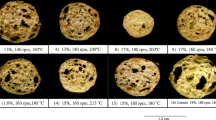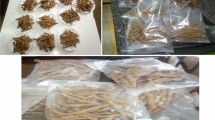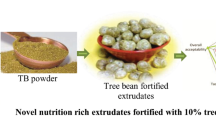Abstract
The snack foods market is currently demanding healthier products. A ready-to-eat expanded snack with high nutritional and antioxidant value was developed from a mixture (70:30) of whole amarantin transgenic maize (Zea mays L.) and black common bean (Phaseolus vulgaris L.) by optimizing the extrusion process. Extruder operation conditions were: feed moisture content (FMC, 15–25 %, wet basis), barrel temperature (BT, 120–170 °C), and screw speed (SS, 50–240). The desirability numeric method of the response surface methodology (RSM) was applied as the optimization technique over four response variables [expansion ratio (ER), bulk density (BD), hardness (H), antioxidant activity (AoxA)] to obtain maximum ER and AoxA, and minimum BD, and H values. The best combination of extrusion process variables for producing an optimized expanded snack (OES, healthy snack) were: FMC = 15 %/BT = 157 °C/SS = 238 rpm. The OES had ER = 2.86, BD = 0.119 g/cm3, H = 1.818 N, and AoxA = 13,681 μmol Trolox equivalent (TE)/100 g, dry weight. The extrusion conditions used to produce the OES increased the AoxA (ORAC: +18 %, ABTS:+20 %) respect to the unprocessed whole grains mixture. A 50 g portion of OES had higher protein content (7.23 vs 2.32 g), total dietary fiber (7.50 vs 1.97 g), total phenolic content (122 vs 47 mg GAE), and AoxA (6626 vs 763 μmol TE), and lower energy (169 vs 264 kcal) than an expanded commercial snack (ECS = Cheetos™). Because of its high content of quality protein, dietary fiber and phenolics, as well as high AoxA and low energy density, the OES could be used for health promotion and chronic disease prevention and as an alternative to the widely available commercial snacks with high caloric content and low nutritional/nutraceutical value.

Similar content being viewed by others
References
Liu RH (2007) Whole grain phytochemicals and health. J Cereal Sci 46:207–219
USDA (2010) Antioxidants and health. ACES publications, p. 4
FAOSTAT (2012) Statistical Database. Online reference: http://faostat.fao.org/site/567/DesktopDefault.aspx?PageID¼567#ancor. Accessed 28.07.12.
FAO (2013) Findings and recommendations of the 2011 FAO expert consultation on protein quality evaluation in human nutrition. FAO food and nutrition paper 92. In: dietary protein quality evaluation in human nutrition: report of an FAO expert consultation. Food and Agriculture Organization of the United Nations, Rome, Italy, p. 29 (chapter 4)
Rascón-Cruz Q, Sinagawa-García SR, Osuna-Castro JA, et al. (2004) Accumulation, assembly and digestibility of amarantin expressed in transgenic tropical maize. Theor Appl Genet 108:335–342
Sinagawa-García SR, Rascón-Cruz Q, Valdez-Ortiz A, et al. (2004) Safety assessment by in vitro digestibility and allergenicity of genetically modified maize with an amaranth 11S globulin. J Agric Food Chem 52:2709–2714
Anselmi C, Centini M, Granata P, et al. (2004) Antioxidant activity of ferulic acid alkyl esters in a heterophasic system. J Agric Food Chem 52:6425–6432
Lopez-Martínez LX, Oliart-Ros RM, Valerio-Alfaro G, et al. (2009) Antioxidant activity, phenolic compounds and anthocyanins content of 18 strains of Mexican maize. LWT Food Sci Technol 42:1187–1192
Mora-Rochín S, Gutiérrez-Uribe JA, Serna-Saldívar SO, et al. (2010) Phenolic content and antioxidant activity of tortillas produced from pigmented maize processed by conventional nixtamalization or extrusion cooking. J Cereal Sci 52:502–508
Bazzano L, He J, Ogden LG, et al. (2001) Legume consumption and risk of coronary heart disease in US men and women. Arch Intern Med 161:2573–2578
Aparicio-Fernández X, García-Gasca T, Yousef GG, et al. (2006) Chemopreventive activity of polyphenolics from black jamada bean (Phaseolus vulgaris L.) on HeLa and HaCaT cells. J Agric Food Chem 54:2116–2122
Fast RB (1990) Manufacturing technology of ready to eat cereals. In: Fast RB, Caldwell FE (eds) Breakfast cereals and how they are made. American Association of Cereal Chemists Inc. St. Paul, MN, USA, pp. 15–42
Bouzaza D, Arhaliass A, Bouvier JM (1996) Die design and dough expansion in low moisture extrusion cooking processes. J Food Eng 29:139–152
Escalante-Aburto A, Ramírez-Wong B, Torres-Chávez PI, et al. (2014) Obtaining ready-to-eat blue corn expanded snacks with anthocyanins using an extrusion process and response surface methodology. Molecules 19:21066–21084
Cortés RN, Guzmán IV, Martínez-Bustos F (2014) Effects of some extrusion variables on physicochemical characteristics of extruded corn starch-passion fruit pulp (Passiflora edulis) snacks. Plant Foods Hum Nutr 69:365–371
Reyes-Moreno C, Argüelles-López OD, Rochín-Medina JJ, et al. (2012) High antioxidant activity mixture of extruded whole quality protein maize and common bean flours for production of a nutraceutical beverage elaborated with a traditional Mexican formulation. Plant Foods Hum Nutr 67:450–456
Paredes-López O, Guevara-Lara F, Bello-Pérez LA (2006) Los alimentos mágicos de las culturas indígenas mesoamericanas. Fondo de Cultura Económica. México, DF, pp 32–34, 81–88. ISBN 968–16–7567-3
Perez AA, Drago SR, Carrara CR, et al. (2007) Extrusion cooking of a maize/soybean mixture: factors affecting expanded product characteristics and flour dispersion viscosity. J Food Eng 87:333–340
Perales-Sánchez JX, Reyes-Moreno C, Gómez-Favela MA, et al. (2014) Increasing the antioxidant activity, total phenolic and flavonoid contents by optimizing the germination conditions of amaranth seeds. Plant Foods Hum Nutr 69(3):196–202
AOAC (1999) Official methods of analysis, 16th edn. Association of Official Analytical Chemists, Washington, DC, USA
Esposito F, Arlotti G, Bonifati AM, Napolitano A, Vitale D, Fogliano V (2005) Antioxidant activity and dietary fibre in durum wheat bran by-products. Food Res Int 38:1167–1173
González de Mejia E, Valadez-Vega MC, Reynoso-Camacho R, Loarca-Pina G (2005) Tannins, trypsin inhibitors and lectin cytotoxicity in tepary (Phaseolus acutifolius) and common (Phaseolus vulgaris) beans. Plant Foods Hum Nutr 60:137–145
Xu B, Chang SKC (2008) Effect of soaking, boiling, and steaming on total phenolic content and antioxidant activities of cool season food legumes. Food Chem 110:1–13
Zieliński H, Kozłowska H, Lewczuk B (2001) Bioactive compounds in the cereal grains before and after hydrothermal processing. Innovative Food Sci Emerg Technol 2:159–169
Korus J, Gumul D, Czechowska K (2007) Effect of extrusion on the phenolic composition and antioxidant activity of dry beans of Phaseolus vulgaris L. Food Technol Biotechnol 45(2):139–146
Nicoli MC, Anese M, Parpinel M (1999) Influence of processing on the antioxidant properties of fruit and vegetables. Trends Food Sci Technol 10:94–100. doi:10.1016/S0924-2244(99)00023-0
Milán-Carrillo J, Montoya-Rodríguez A, Gutiérrez-Dorado R, Perales-Sánchez X, Reyes-Moreno C (2012) Optimization of extrusion process for producing high antioxidant instant amaranth (Amaranthus hypochondriacus L.) flour using response surface methodology. Appl Math 3:1516–1525
Garzón-Tiznado JA, Heiras-Palazuelos MJ, Espinoza-Moreno RJ, et al. (2013) Antioxidant and Antimutagenic activities of optimized extruded desi chickpea (Cicer arietinum L.) flours. J Phar Nutri Sci 3(1):38–47
Nems´ A, Pęksa A, AZ K, et al. (2015) Anthocyanin and antioxidant activity of snacks with coloured potato. Food Chem 172:175–182
BFN (2004) British Nutrition Foundation. Dietary fibre. Online reference: http://www.nutrition.org.uk/. Accessed 20 October 2012
Acknowledgments
This research was supported by grants from Programa de Fomento y Apoyo a Proyectos de Investigación - Universidad Autónoma de Sinaloa (2013, 2014).
Author information
Authors and Affiliations
Corresponding author
Ethics declarations
Conflict of Interest Statement
The authors report no conflicts of interest. The authors alone are responsible for the content and writing of the paper.
Electronic supplementary material
ESM 1
(PDF 539 kb)
Rights and permissions
About this article
Cite this article
Espinoza-Moreno, R.J., Reyes-Moreno, C., Milán-Carrillo, J. et al. Healthy Ready-to-Eat Expanded Snack with High Nutritional and Antioxidant Value Produced from Whole Amarantin Transgenic Maize and Black Common Bean. Plant Foods Hum Nutr 71, 218–224 (2016). https://doi.org/10.1007/s11130-016-0551-8
Published:
Issue Date:
DOI: https://doi.org/10.1007/s11130-016-0551-8




